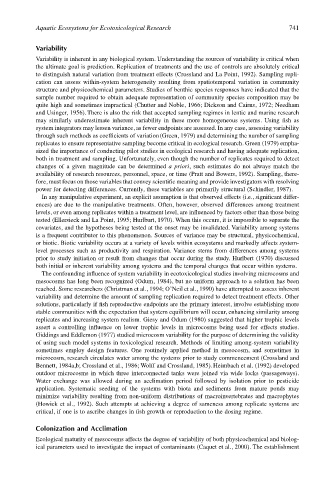Page 761 - The Toxicology of Fishes
P. 761
Aquatic Ecosystems for Ecotoxicological Research 741
Variability
Variability is inherent in any biological system. Understanding the sources of variability is critical when
the ultimate goal is prediction. Replication of treatments and the use of controls are absolutely critical
to distinguish natural variation from treatment effects (Crossland and La Point, 1992). Sampling repli-
cation can assess within-system heterogeneity resulting from spatiotemporal variation in community
structure and physicochemical parameters. Studies of benthic species responses have indicated that the
sample number required to obtain adequate representation of community species composition may be
quite high and sometimes impractical (Chutter and Noble, 1966; Dickson and Cairns, 1972; Needham
and Usinger, 1956). There is also the risk that accepted sampling regimes in lentic and marine research
may similarly underestimate inherent variability in these more homogeneous systems. Using fish as
system integrators may lessen variance, as fewer endpoints are assessed. In any case, assessing variability
through such methods as coefficients of variation(Green, 1979) and determining the number of sampling
replicates to ensure representative sampling become critical in ecological research. Green (1979) empha-
sized the importance of conducting pilot studies in ecological research and having adequate replication,
both in treatment and sampling. Unfortunately, even though the number of replicates required to detect
changes of a given magnitude can be determined a priori, such estimates do not always match the
availability of research resources, personnel, space, or time (Pratt and Bowers, 1992). Sampling, there-
fore, must focus on those variables that convey scientific meaning and provide investigators with resolving
power for detecting differences. Currently, these variables are primarily structural (Schindler, 1987).
In any manipulative experiment, an explicit assumption is that observed effects (i.e., significant differ-
ences) are due to the manipulative treatments. Often, however, observed differences among treatment
levels, or even among replicates within a treatment level, are influenced by factors other than those being
tested (Ellersieck and La Point, 1995; Hurlburt, 1970). When this occurs, it is impossible to separate the
covariates, and the hypotheses being tested at the onset may be invalidated. Variability among systems
is a frequent contributor to this phenomenon. Sources of variance may be structural, physicochemical,
or biotic. Biotic variability occurs at a variety of levels within ecosystems and markedly affects system-
level processes such as productivity and respiration. Variance stems from differences among systems
prior to study initiation or result from changes that occur during the study. Hurlbert (1970) discussed
both initial or inherent variability among systems and the temporal changes that occur within systems.
The confounding influence of system variability in ecotoxicological studies involving microcosms and
mesocosms has long been recognized (Odum, 1984), but no uniform approach to a solution has been
reached. Some researchers (Christman et al., 1994; O’Neil et al., 1990) have attempted to assess inherent
variability and determine the amount of sampling replication required to detect treatment effects. Other
solutions, particularly if fish reproductive endpoints are the primary interest, involve establishing more
stable communities with the expectation that system equilibrium will occur, enhancing similarity among
replicates and increasing system realism. Giesy and Odum (1980) suggested that higher trophic levels
assert a controlling influence on lower trophic levels in microcosms being used for effects studies.
Giddings and Eddlemon (1977) studied microcosm variability for the purpose of determining the validity
of using such model systems in toxicological research. Methods of limiting among-system variability
sometimes employ design features. One routinely applied method in mesocosm, and sometimes in
microcosm, research circulates water among the systems prior to study commencement (Crossland and
Bennett, 1984a,b; Crossland et al., 1986; Wolff and Crossland, 1985). Heimbach et al. (1992) developed
outdoor microcosms in which three interconnected tanks were joined via wide locks (passageways).
Water exchange was allowed during an acclimation period followed by isolation prior to pesticide
application. Systematic seeding of the systems with biota and sediments from mature ponds may
minimize variability resulting from non-uniform distributions of macroinvertebrates and macrophytes
(Howick et al., 1992). Such attempts at achieving a degree of sameness among replicate systems are
critical, if one is to ascribe changes in fish growth or reproduction to the dosing regime.
Colonization and Acclimation
Ecological maturity of mesocosms affects the degree of variability of both physicochemical and biolog-
ical parameters used to investigate the impact of contaminants (Caquet et al., 2000). The establishment

